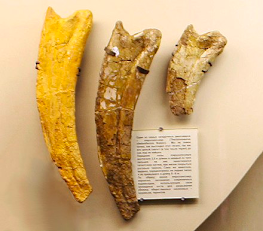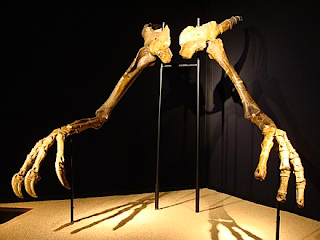Fossil Friday #6 - Therizinosaurus
A typical Theropod dinosaur fits a rather uniform description. They mostly had large skulls, relatively small forelimbs, and were the apex predators in most of the niches that they filled. However, like most trends in the natural world, there were exceptions. Perhaps the most extraordinary of these exceptions were the herbivorous Therizinosaurs, and more specifically the infamous Therizinosaurus cheloniformis.
Therizinosaurus has etched its way into popular culture of late, being one of the star dinosaurs in the latest installment of the Jurassic World franchise, and getting its own segment in the well-received Prehistoric Planet docuseries. It has quickly become one of the most iconic dinosaurs in mainstream media, however, it is easy to forget that it has actually been known about for quite some time, as the first specimen was named in 1954.
Discovered by a team of Soviet geologists in one of the most important dinosaur fossil sites in the world, the Late Cretaceous Nemegt Formation of Mongolia, the first fossils found of Therizinosaurus were part of its iconic claws. Due to an array of turtles being found in this area, and the lack of knowledge on Therizinosaurs at the time, it was described to be a large species of turtle-like reptile, that may have used its claws to harvest seaweed (Zanno et al, 2010). This matter seemed to be settled until 1970, when Anatoly Rozhdestvensky suggested that it could be a theropod, highlighting the similarities between its unguals (claws) and those of the Chilantaisaurus tashuikouensis, a carnivorous theropod from late cretaceous China. This claim was further supported by the well-timed discovery of Deinocheirus mirificus (a species of Ornithomimosaur) in 1970. This was another herbivorous theropod from the Nemegt Formation, with fossil remains that show the large claws attached to forelimbs, supporting Rozhdestvensky's theory on Therizinosaurus (Osmólska and Roniewicz, 1970).
Holotype unguals of Therizinosaurus Holotype specimen of Deinocheirus mirificus.
cheloniformis, first thought to belong to
a turtle-like reptile.
Therizinosaurs are classed under Maniraptora, the clade that also includes Dromaeosaurs and modern birds. This suggests that Therizinosaurus may have been one of, if not the largest feathered animal to ever live, although there has been no direct fossil evidence of feathers on a Therizinosaurus. Standing at 4-5 metres tall, 9-10 metres in length and possessing its colossal claws, it would not have been an easy target for apex predators in cretaceous Mongolia, such as Tarbosaurus bataar (Campione and Evans, 2020). Its scythe-like claws may have had several uses. Being a herbivore, it almost certainly used them to reach and harvest vegetation from branches that other herbivores may not have been able to reach, as they measured almost a metre in length (Zanno et al, 2010). It may have also used them for display to attract mates or to warn off predators, and in extreme circumstances may have used them in combat against predators or even other Therizinosauruses. This may seem speculative, however, as more specimens would need to be discovered in order to learn more about the function of its claws (Lautenschlager, 2014), however, further study has found that the humeri of Therizinosaurus would have been able to withstand significant stress forces, suggesting they would have in fact been used for combat, despite the limited fossil record (Lee and Richard, 2018).
The reconstruction of such a remarkable animal despite limited fossil evidence is an ode to the computational and phylogenetic techniques that palaeontologists use to study ancient life. Given even a fraction of an individual dinosaur, we can reconstruct how it may have looked, behaved, eaten and moved, as is the case with Therizinosaurus, which has become one of the most iconic dinosaurs of the late Cretaceous.
Reconstruction of Therizinosaurus cheloniformis, showing feathers, based on the fact that it falls under the Maniraptora clade, of which several species have been found with fossilised evidence of feathers.
References
Campione, N. E.; Evans, D. C. (2020). "The accuracy and precision of body mass estimation in non-avian dinosaurs". Biological Reviews. 95 (6): 1759–1797. doi:10.1111/brv.12638.
Lautenschlager, S. (2014). "Morphological and functional diversity in therizinosaur claws and the implications for theropod claw evolution". Proceedings of the Royal Society B. 28 (1785): 20140497. doi:10.1098/rspb.2014.0497
Lee, S. A.; Richards, Z. (2018). "The Surprisingly Strong Arms of the Therizinosaur Dinosaurs". The Physics Teacher. 56 (7): 432–435.
Osmólska, H.; Roniewicz, E. (1970). "Deinocheiridae, a new family of theropod dinosaurs". Palaeontologica Polonica (21): 5–19.
Zanno, L. E. (2010). "A taxonomic and phylogenetic re-evaluation of Therizinosauria (Dinosauria: Maniraptora)". Journal of Systematic Palaeontology. 8 (4): 503-543. doi:10.1080/14772019.2010.488045





Comments
Post a Comment